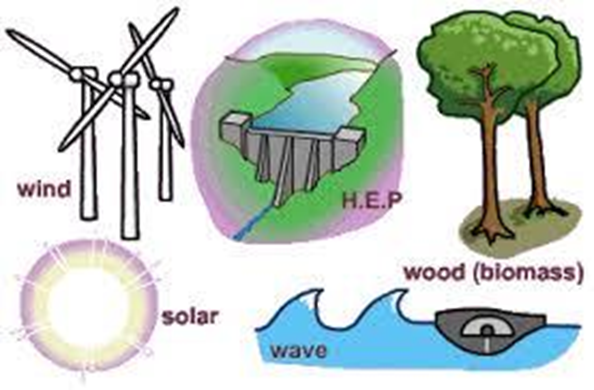RENEWABLE AND NON-RENEWABLE RESOURCES
Intended
Learning Outcomes
At the end of this session, students will be able to
• Explain renewable resources
• Discuss non-renewable resources
Contents
• Renewable
resources
• Non-renewable
resources
Natural Resources
• Perpetual
– Solar – renewed continuously
• Renewable
– Replenished fairly rapidly through natural processes
• Non-renewable
– Minerals
Renewable
and Non-Renewable Resources
• Ecosystems act as resource producers and processors
• Solar energy is the main driving force of ecological
systems, providing energy for the growth of plants in forests, grasslands and
aquatic ecosystems
• A forest recycles its plant material slowly by
continuously returning its dead material, leaves, branches, etc. to the soil
• Grasslands recycle material much faster than forests as
the grass dries up after the rains are over every year
• All the aquatic ecosystems are also solar energy dependent
and have cycles of growth when plant life spreads and aquatic animals breed
• Sun also drives the water cycle
• Our food comes from both natural and agricultural
ecosystems
• Traditional agricultural ecosystems that depended on
rainfall have been modified in recent times to produce more and more food by
the addition of extra chemicals and water from irrigation systems but are still
dependent on solar energy for the growth of crops
• Moreover modern agriculture creates a variety of
environmental problems, which ultimately lead to the formation of unproductive
land
• These include irrigation, which leads to the development
of saline soil and the use of artificial fertilizers eventually ruin soil
quality and pesticides, which are a health hazard for humans as well as
destroying components vital to the long-term health of agricultural ecosystems
• To manufacture consumer products, industry requires raw
materials from nature, including water, minerals and power
• During the manufacturing process, gases, chemicals and
waste products pollute our environment, unless the industry is carefully
managed to clean up this mess
Non-renewable
resources
• These are minerals that have been formed in the
lithosphere over millions of years and constitute a closed system
• These non-renewable resources, once used, remain on earth
in a different form and unless recycled become waste material
• Non-renewable resources include fossil fuels such as oil
and coal, which if extracted at the present rate, will soon be totally used up
• End products of fossil fuels are in the form of heat and
mechanical energy and chemical compounds, which cannot be reconstituted as a
resource
Resource that exists in a fixed amount (stock) in various
places in the earth’s crust and has the potential for renewal by geological,
physical, and chemical processes taking place over hundreds of millions to
billions of years.
• Energy, metals, and other minerals
• Examples are copper, aluminum, iron, salt, clay, coal, and
oil.
• Any potentially renewable resource can become
non-renewable if used improperly
• Theoretically, never exhaust due to economic feasibility
for extracting.
Renewable
resources
• Though water and biological living resources are
considered renewable, they are in fact renewable only within certain limits
• They are linked to natural cycles such as the water cycle
1. Fresh water (even after being used) is evaporated by the
sun’s energy, forms water vapour and is reformed in clouds and falls to earth
as rain
2. Water sources are heavily polluted by sewage and toxic
substances that it becomes impossible to use the water
3. Forests, once destroyed take thousands of years to
re-grow into fully developed natural ecosystems with their full complement of
species
4. Fish are today being over-harvested until the catch has
become a fraction of the original resource and the fish are incapable of
breeding successfully to replenish the population
5. Output of agricultural land if mismanaged drops
drastically
6. When the population of a species of plant or animal is
reduced by human activities, until it cannot reproduce fast enough to maintain
a viable number, the species becomes extinct
7. Many species are probably becoming extinct without us
even knowing, and other linked species are affected by their loss
• Sustainable yield
– Highest rate at which a potentially renewable resource can
be used without reducing its available supply throughout the world or in a
particular area.
Summary
• Ecosystems act as resource producers and processors
• Sun also drives the water cycle
• Non-renewable resources are minerals that have been formed
in the lithosphere over millions of years and constitute a closed system
• Renewable resources are biological living resources, they
are in fact renewable only within certain limits



